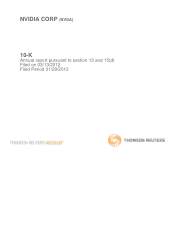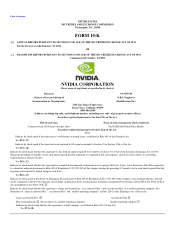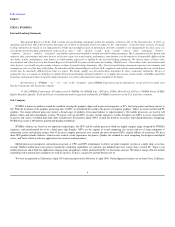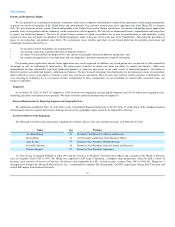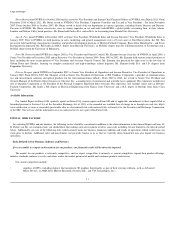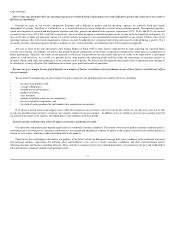NVIDIA 2012 Annual Report Download - page 10
Download and view the complete annual report
Please find page 10 of the 2012 NVIDIA annual report below. You can navigate through the pages in the report by either clicking on the pages listed below, or by using the keyword search tool below to find specific information within the annual report.
Table of Contents
A critical component of our product development effort is our partnerships with leaders in the computer-aided design industry. We invest significant
resources in the development of relationships with industry leaders, often assisting these companies in the product definition of their new products. We
believe that forming these relationships and utilizing next-generation development tools to design, simulate and verify our products will help us remain at the
forefront of the 3D graphics market and develop products that utilize leading-edge technology on a rapid basis. We believe this approach assists us in meeting
the new design schedules of PC OEMs and other manufacturers.
As of January 29, 2012, we had 5,042 full-time employees engaged in research and development. During fiscal years 2012, 2011 and 2010, we incurred
research and development expense of $1,002.6 million, $848.8 million and $908.9 million, respectively.
Competition
The market for our products is intensely competitive and is characterized by rapid technological change, evolving industry standards and declining
average selling prices. We believe that the principal competitive factors in this market are performance, breadth of product offerings, access to customers and
distribution channels, software support, conformity to industry standard Application Programming Interfaces, manufacturing capabilities, processor pricing
and total system costs. We believe that our ability to remain competitive will depend on how well we are able to anticipate the features and functions that
customers will demand and whether we are able to deliver consistent volumes of our products at acceptable levels of quality and at competitive prices. We
expect competition to increase from both existing competitors and new market entrants with products that may be less costly than ours, or may provide better
performance or additional features not provided by our products. In addition, it is possible that new competitors or alliances among competitors could emerge
and acquire significant market share.
A significant source of competition comes from companies that provide or intend to provide GPUs and mobile and consumer products. Some of our
competitors may have greater marketing, financial, distribution and manufacturing resources than we do and may be more able to adapt to customer or
technological changes.
Our current competitors include:
•suppliers of GPUs, including chipsets that incorporate 3D graphics functionality as part of their existing solutions, such as Advanced
Micro Devices, or AMD, Intel, Matrox Electronics Systems Ltd. and VIA Technologies, Inc.;
•suppliers of system-on-chip products that support tablets, smartphones, portable media players, internet television, automotive
navigation and other similar devices, such as AMD, ARM Holdings plc, Broadcom Corporation, Freescale Semiconductor Inc.,
Fujitsu Limited, Imagination Technologies Ltd., Intel, Marvell Technology Group Ltd., NEC Corporation, Qualcomm Incorporated,
Renesas Technology Corp., Samsung Electronics Co. Ltd., Seiko Epson Corporation, ST-Ericsson, Texas Instruments Incorporated
and Toshiba America Electronic Components, Inc.;
• licensors of graphics technologies, such as ARM Holdings plc and Imagination Technologies Group plc.; and
•suppliers of cellular basebands such as Broadcom Corporation, Freescale Semiconductor Inc., HiSilicon Technologies Co., Ltd., Intel,
Marvell Technology Group Ltd., Mediatek, Qualcomm Incorporated, Renesas Technology Corp., Samsung Electronics Co. Ltd.,
Spreadtrum Communications Co., Ltd, ST-Ericsson, and Texas Instruments Incorporated.
If and to the extent we offer products in new markets, we may face competition from existing competitors as well as from companies with which we
currently do not compete. We expect substantial competition from both Intel's and AMD's strategy of selling platform solutions, including integrating a CPU
and a GPU on the same chip or same package, as evidenced by AMD's announcement of its Fusion processors and Intel's announcement of its family of CPUs
codenamed Sandy Bridge. As AMD and Intel continue to pursue platform solutions and integrated CPUs, we may not be able to successfully compete and our
business could be negatively impacted.
9

